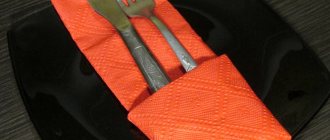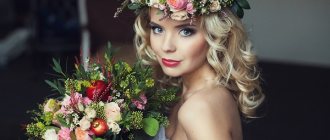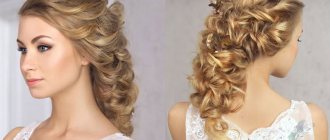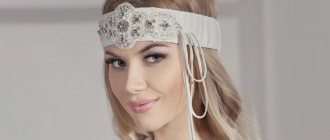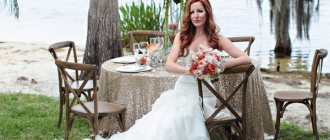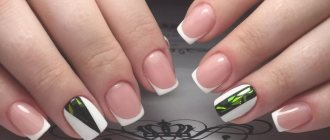Basic rules for using napkins for serving
Paper and fabric napkins are used to decorate the holiday table. They perform an aesthetic and practical function. The color, size and options for folding napkins during table setting are chosen depending on the degree of solemnity of the meal, as well as its type.
When setting, cloth napkins are placed on the table in only one way. Paper ones are usually placed in a common napkin holder, and are also placed under each guest’s plate on the right side.
For breakfast, choose simple forms. According to the rules of etiquette, it is recommended to fold fabric napkins for table setting into four, into a triangle, an envelope, or a tube. For lunch or dinner, it is customary to fold napkins in other ways, namely: with a cap, a crown, or a cap. When preparing for a banquet, more complex methods of folding napkins are used, for example, in the form of flowers, a herringbone, a fan, a butterfly.
Design and decor
- Celebration color scheme.
The most suitable colors for a French wedding will be delicate colors: pastel colors and shades of pink. - Details that create the basis of the wedding style:
Let the florists decorate the room with fresh flowers. And most importantly, do not forget to place small delicate bouquets on the banquet table. - Don't forget to prepare bonbonnieres for your guests. They must correspond to the general theme. For example, these could be small boxes of dragees and chocolate.
- Also be sure to think about the decor of invitations and place cards.
Varieties
Both linen and paper napkins are not the same in quality, color and size. Which products to choose depends on the specific case. A classic option for a formal formal dinner is white linen table linen. For an informal setting - cotton and satin products of any color that harmonizes with the tablecloth. Modern fabric napkins are made from mixed fabrics. They do not deform after drying, iron well, and do not shrink when washed.
Sometimes the use of paper napkins is allowed, but according to etiquette, fabric options are preferable.
The size of fabric napkins varies from 25 to 60 cm. Small square products with a side of 25, 30, 35 cm are suitable for decorating tea parties, buffets, coffee tables, and dessert tables. Large ones, with side lengths from 60 to 80 cm, are used to create complex shapes. Linen squares measuring 50 by 50 cm are universal. To create some shapes, you need rectangular napkins, but if there are none, then just fold the square in half.
To beautifully fold fabric napkins for table setting, they need to be starched. Slightly damp starched items are ironed, allowed to cool, and then immediately used for decoration.
Table textiles cannot be starched in advance. During storage, creases form on it, which are very difficult to smooth out.
Thin paper napkins are used during dinner with the family. Multi-layered colored or white items are laid out on the festive table. They are left whole or cut into triangles.
Linen
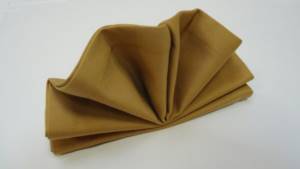
Satin
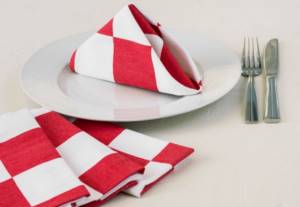
Cotton

Paper napkins
DIY decorations made from paper napkins for a wedding

Often the color of white linen is used for decoration; the product itself must have a square shape and be treated with starch, otherwise it will be extremely difficult to create a stable figure.
Flower
A wedding is a tender and romantic holiday, so various flower decorations are often used to decorate the banquet hall.
You can support this design style with flower-shaped napkins. After creation, the decor is placed in a glass with a high stem.
When choosing a color scheme for decoration, you need to take into account the tonality of the entire style.
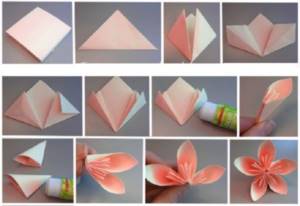
The process of creating a composition itself consists of the following stages:
- The square product is folded in half. The fold line is smoothed by hand.
- After this, the decoration is folded in half again to give it a square shape again.
- An accordion-shaped workpiece is created diagonally. As a result, 3 folds about 2.5 cm wide should form.
- The small angle formed at the top needs to be bent inward. Then, pressing the composition in the center, its edges are slightly extended.
- The decoration is placed in the glass with an angle downwards, the ends are neatly distributed along the walls of the container.
- By repeating the previous procedures, several more layers of petals are created.
Popular folding methods
The options for folding napkins when setting the table are very varied. Experienced craftsmen create complex designs from paper and linen squares. Those who are just beginning to master the art of decorating choose simpler shapes.
Candle
The figure is appropriate during a New Year's feast or evening meal. Looks good in any color. Place “candles” on snack plates or in glasses. You can roll the fabric into a candle in the classic way, leaving its middle hollow, or in an original way, forming a “flame” or “wick” at the end.
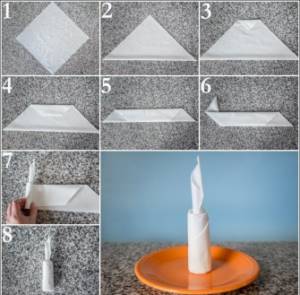
Wick
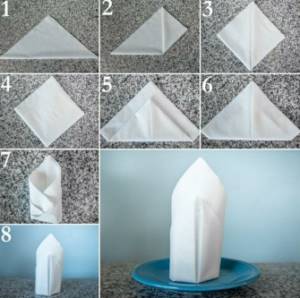
Flame
Lotus
To create fabric flowers, the size of the napkins matters. The side of each square should not be less than 50 cm. “Lotus” is rolled up from pastel-colored fabric and used for a wedding banquet or romantic dinner. Flowers in blue, pink, peach or lilac look especially beautiful.
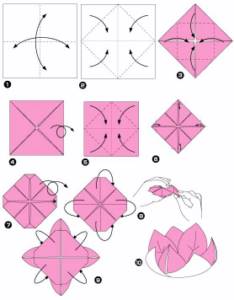
Tulip
This beautiful option is suitable for decorating a celebration of any level. “Tulip” is folded in two ways: on a leg, using 2 squares, or in the form of a cup - from one. Traditional shades for this figure are red, pink, yellow or orange - from pastel to bright, depending on the occasion.
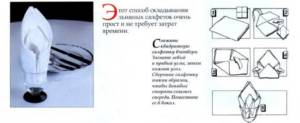
Crown
For official banquets, this option is performed in white. For weddings and anniversaries - in gold or silver. Folded figures should be formed from squares with a side of 50–60 cm. This folding method looks impressive, but does not draw too much attention to itself. Ideal for table setting in honor of a man's birthday.
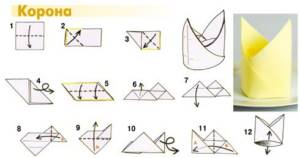
Heart
To create this simple figure, red textiles are usually used. “Heart” is suitable for decorating a romantic dinner and a wedding feast. This figure is often used for table setting on the occasion of Valentine's Day.
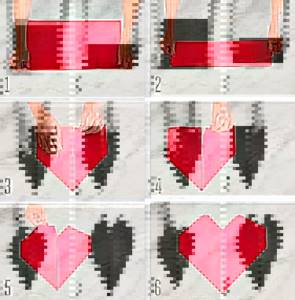
Fan
Looks equally good on a plate and in a glass. Depending on the chosen color, it will decorate any event. Subdued colors are used for a friendly party, bright colors are used for a children's party. This is one of the most versatile options.
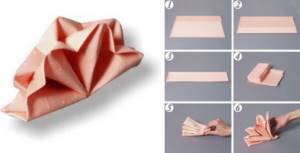
Butterfly
When serving, use various options for folding napkins in the form of this figure. The “butterfly” is created from colored fabric or fabric with a small pattern. Usually this figure is used for a men's holiday. If the hero of the occasion is a little boy, then you can take bright napkins; for a respectable gentleman, more austere colors are suitable.
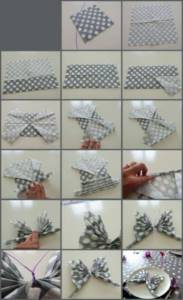
Herringbone
Suitable for a family New Year's feast and festive banquet. The figure is made from textiles of any color that harmonizes with the dishes and tablecloth. An additional accent will be a shiny bead or wooden star on the top.
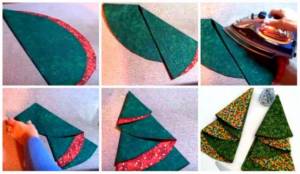
With space for a guest card
This method of folding fabric is used at official receptions where people who do not know each other are invited. Also suitable for a large-scale event (wedding or anniversary) with a large number of guests. It can be made in 2 versions: a simple bag or in the form of an envelope.
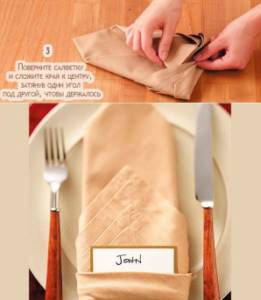
With napkin ring
One of the most beautiful ways to fold table textiles. A napkin decorated in this way is folded into the shape of a fan, flower, butterfly, and is used both at large feasts on the occasion of a wedding or prom, and at family celebrations. The option looks very original and elegant.
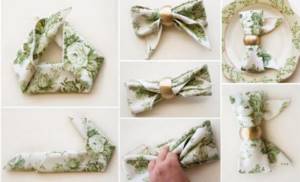
Under devices
The easiest way to fold woven products. Rectangular envelopes are made from textile squares, into which knives, spoons, and forks suitable for a given meal are placed. In addition to the envelope, there are other types of shapes for placing cutlery: a cone-shaped pocket, a hexagon.
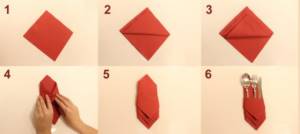
How to decorate your wedding with figures made from fabric napkins
Creating unusual shapes from fabric yourself is not very difficult. You just need to carefully adhere to the technology of doing the work, and then the result will not be long in coming.
This video will show you easy ways to decorate a wedding table with original napkins:
The resulting figures will not only help decorate the celebration, but will also allow you to surprise guests with your abilities.
A figure in the shape of a rose will look stylish and gentle at a wedding. You just need to choose the color of the decoration according to the style of the celebration.
A rose created using a combination of pink, green and red will look good.

The process of creating such a figure is as follows:
- The first step is to form a rosebud. To do this, the napkin is folded diagonally from different sides.
- The resulting triangle is folded into a strip about 5 cm wide.
- The strip is rolled into a roll, which will be a flower bud.
- The ending is fixed in the inner part of the bud.
- Green napkins, which will act as flowers, are collected from different ends towards the center. From the remaining ends, the sides are bent 2-3 cm in the same direction.
- The green decoration is placed in containers. The created bud is mounted inside.
A fairly common technique for folding napkins is to create a table fan.
Such products can be created from various fabrics.
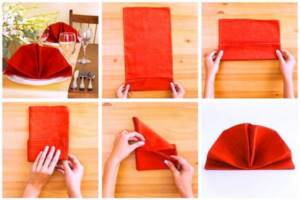
The process of creating such decoration consists of the following procedures:
- The base folds in half.
- On one side, for most of the length, the figure is gathered into an accordion, with the first fold should be placed inside.
- The accordion bends down.
- The section that is not folded like an accordion is bent, and the end of the corner should be between the folds.
- The fan is straightened and placed on the table.
Regular and French envelope
Envelopes for cutlery are quite often created for table setting at holidays. They help protect forks, spoons and knives from dirt.
Creating such figures yourself will not be a problem.
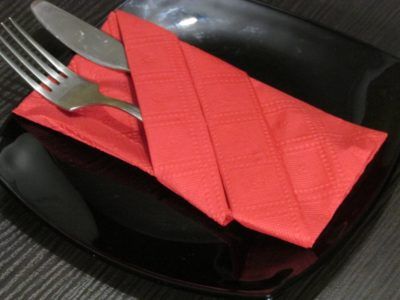
The creation instructions are as follows:
- The starched fabric is folded 4 times to form a square shape.
- The top layer of the figure is turned corner to corner diagonally. The resulting line is carefully smoothed out.
- The same procedure is repeated for the next layer of fabric. But this time the side is not bent to its full length: there should be a small gap between the layers. You need to check that the bent corners are at the same level.
- The third one develops similarly to the previous ones.
- The napkin is unfolded with the reverse side so that the layers are turned with the front part towards the table.
- The figure is gathered with corners towards each other and wrapped about a third of the width. The fold line is ironed so that the product retains its shape.
The result is a French envelope. To create a regular envelope you will need fewer layers.
How to lay it out beautifully
Setting the table with fabric napkins depends on the type of meal, the number of dishes and the type of linen figure. Etiquette allows for the following methods of placing table textiles:
- parallel to the dessert cutlery, closer to the center of the table, if the napkin is rolled up;
- in the center of the appetizer plate, if the table is set for a full dinner with a large number of plates, glasses and cutlery;
- to the left of the hot plate (after the last fork), when the product is folded into a triangle, envelope or tube;
- in the middle of a small dinner plate for hot dishes if there is no appetizer plate on it;
- between spoons and forks, if already filled dishes are placed in front of the cutlery;
- on the far edge of the serving plate, in the center of which there is a pair of teas;
- in a glass (glass) to create a special atmosphere during a romantic dinner or a themed feast.
To make the linen figures look organic among other cutlery, they are placed on plates of small diameter, on average 20 cm. Wine glasses and glasses for this purpose are tall, with a volume of 300–500 ml. In the bowl of a glass, the options “candle”, “tulip”, “fan”, “bouquet”, “horn”, “tower” look especially impressive.
It is permissible to fold napkins directly on the tabletop in the form of a flat figure or tube. Complex tall versions of textile decorations are placed only on plates or in wine glasses.
Usage etiquette
Table napkins made of fabric protect clothes from possible drops from food and drinks. In addition, they are applied to slightly stained fingertips and lips after each sip from a glass or cup. Etiquette strictly prohibits wiping sweat, lipstick, or heavily soiled hands with a cloth. Do not use it as a handkerchief, or wipe cutlery, glasses, or telephone with textiles. There is a paper equivalent for this.
The cloth napkin is used in the following order:
- The rolled-up material is taken in a pinch and shaken, keeping your hand away from the dish. At a home dinner party, the hostess (or, in her absence, the host) of the house unwraps the napkin first. In a restaurant, the woman performs this action first. If there are only men at the table, then the inviting party takes the textile product first. This gesture is a signal for the start of the meal; now guests can unwrap the fabric figures. In a restaurant, the napkin is unrolled only after the first course is served. When they place an order and drink an aperitif, they do not touch it.
- Now you need to fold the napkin in half. In this form, it is placed on your knees with the open edge facing you.
- During the meal, fingers are wiped with the half lying on top, without removing the product from the knees. To blot the lips, the upper edge of the square is folded inward by 5–7 cm, the material is lifted to the mouth in an unfolded form, holding it by the fold, and then returned to the knees in its original position with the clean part down.
- When all the dishes have been eaten, the woven square is taken by the center and placed to the left of the plate on the table.
If you need to leave the table for a while, place the napkin on the chair. This is a signal that the guest has not finished eating yet and will return. If a textile item has slipped from your lap, they do not pick it up, but ask the hostess or waiter to bring a clean one.
If setting the table with fabric napkins is not intended, use paper counterparts. With a large square, perform the same actions as with a linen product. A small paper triangle is folded with the top to the base, and then in half, and placed under the edge of the plate. If necessary, take it out, wipe your hands and mouth with the inside, then fold it again and return it to its place.
According to etiquette, each time you need to take a clean paper triangle, and roll the used one and place it under the edge of the plate. After eating, dirty napkins are placed on the plate.
You should pay no less attention to folding napkins for table setting than to selecting tableware and decorative elements. Beautifully folded textiles will add status to even a modest feast.
